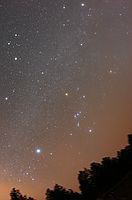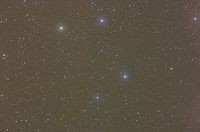Stargazing Night Two
We spent the daylight hours today looking around northern New Mexico. We went in a big triangle from Las Vegas, NM to Taos, then over to Santa Fe and back. The day was peppered with two complications. First was altitude. With Tammy being pregnant she is not supposed to exceed 7,000 to 8,000 feet of elevation. If you are a low-lander as we are, going higher than this deprives you, and more importantly the baby, of much needed oxygen. We really don’t know more than this and as we drove to Taos crossing the Monte Cristo mountains and definitely higher than 8,000 feet we were worried. All is fine I’m sure, we only crossed the range for 20-30 minutes and then dropped back into normal levels. But, that doesn’t keep first time parents from worrying, worrying and worrying.
The other issue that introduced fun was the caked on mud from yesterdays experience getting stuck. The wheels on the right hand side of the car were way out of balance due to caked on mud and required a power hose and chiseling with a screwdriver to stop vibrating like crazy.
Taos was a cool city. I had the best quesadilla I’ve EVER had for lunch. Wow. The town square in Taos was interesting and had a number of galleries including a piece that we would have loved but for the price. We returned through Santa Fe, avoiding another crossing of the mountains. We also got to preview where we are staying when we head to Santa Fe in a couple days, and it looks great.
 We returned to the Star Hill right at dusk. The sky looked really bad as
we approached, very cloudy. But there was a break in the clouds as night
came and we still got some good viewing, however it never got as good as
last night. Phil met me on the observation deck and Tammy decided to
stay back and read. She's decided astronomy is not her hobby. "It's just
a bunch of stars!" she says. I told her how it's so amazing that this
star millions of light years away is throwing photons into space and
then we're here on earth capturing those photons into our eye! Isn't
that cool? She didn't agree. 🙂
We returned to the Star Hill right at dusk. The sky looked really bad as
we approached, very cloudy. But there was a break in the clouds as night
came and we still got some good viewing, however it never got as good as
last night. Phil met me on the observation deck and Tammy decided to
stay back and read. She's decided astronomy is not her hobby. "It's just
a bunch of stars!" she says. I told her how it's so amazing that this
star millions of light years away is throwing photons into space and
then we're here on earth capturing those photons into our eye! Isn't
that cool? She didn't agree. 🙂
Tammy’s Comment: The quote that Jamie has me saying makes me sound a bit more shallow than I’d like. I’m not sure that I ever said those exact words anyway. Not that anyone cares but me, but I must clarify why I am not a telescope-liking gal. I thought that when you looked through a telescope, you would see what you see when you look at pictures that people have taken of the night sky. But, this is not the case. What you see instead is stuff that looks very similar to the stuff that you see when you look at the sky with your eyes. I understand that you are seeing different stuff, stuff that you can’t see with your naked eye, but it doesn’t look much different. Add to that the fact that it’s cold out and you just stand there and it takes awhile to get each thing into focus and once you finally do, it’s somewhat difficult to look through the eyepiece as you have to be at a very specific angle, and I much prefer just looking up at the sky. The only exception I would make is for the planets. You can see them when you look at the sky, but they look like stars. When you see them through the telescope they actually look like planets. They still don’t look as cool as they do in the pictures, but they look good enough that it’s worth looking through the telescope to see them.
 Phil set up a sidereal camera mount and I took a number of shots with my
camera, no telescope involved. I captured a few constellations with 4 to
8 minute exposures. It's stunning what you can get just by pointing a
camera in the sky and leaving the shutter open. Mostly I used my 14mm
full-frame fish-eye which did great. I also captured Jupiter and it's
moons using a 100mm telephoto. We decided not to do the CCD and stuck
with the smaller 12" SCT instead of the 16" on the count of the clouds.
We'll try tomorrow night for the larger scope. I think I may just skip
the CCD and use my camera with a T-mount instead. The CCD imager is
pretty touchy, requires a ton of time for focusing and then must be
hooked up to a laptop. Much easier to just put my camera on the
telescope. Of course all of that depends on me finding a T-adapter in
Santa Fe which may be trickier than I would like.
Phil set up a sidereal camera mount and I took a number of shots with my
camera, no telescope involved. I captured a few constellations with 4 to
8 minute exposures. It's stunning what you can get just by pointing a
camera in the sky and leaving the shutter open. Mostly I used my 14mm
full-frame fish-eye which did great. I also captured Jupiter and it's
moons using a 100mm telephoto. We decided not to do the CCD and stuck
with the smaller 12" SCT instead of the 16" on the count of the clouds.
We'll try tomorrow night for the larger scope. I think I may just skip
the CCD and use my camera with a T-mount instead. The CCD imager is
pretty touchy, requires a ton of time for focusing and then must be
hooked up to a laptop. Much easier to just put my camera on the
telescope. Of course all of that depends on me finding a T-adapter in
Santa Fe which may be trickier than I would like.
The first image above is of Orion with the Milky Way band in the background. The second picture is of the bucket of the big dipper.